
German Protestant Institute
Encyclopedia

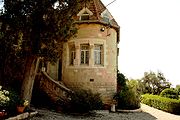
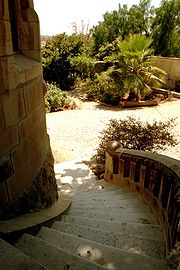
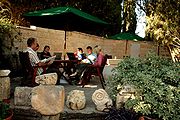
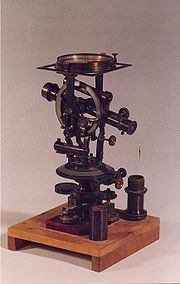
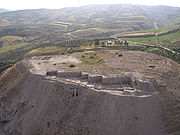
German language
German is a West Germanic language, related to and classified alongside English and Dutch. With an estimated 90 – 98 million native speakers, German is one of the world's major languages and is the most widely-spoken first language in the European Union....
name is Deutsches Evangelisches Institut für Altertumswissenschaft des Heiligen Landes.
Institutes
The German Protestant Institute of Archaeology, Research Unit of the German Archaeological Institute, operates in two locations – Jerusalem and AmmanAmman
Amman is the capital of Jordan. It is the country's political, cultural and commercial centre and one of the oldest continuously inhabited cities in the world. The Greater Amman area has a population of 2,842,629 as of 2010. The population of Amman is expected to jump from 2.8 million to almost...
. Its high reputation as cultural institution, help desk, and meeting place for European scholars makes it a sought-after partner for cooperation between German and international organizations and projects. The GPIA is a foundation administered by the German Protestant Church. At the same time, it serves as a research unit of the German Archaeological Institute
German Archaeological Institute
The German Archaeological Institute is an institution of research within the field of archaeology , and a "scientific corporation", with parentage of the federal Foreign Office of Germany-Origin:...
(DAI) and receives financial support from the German Foreign Ministry.
- Institute Jerusalem,
Director-General: Professor Dr. Dr. Dr. h.c. Dieter Vieweger
Dieter Vieweger
Dieter Vieweger, a German Biblical scholar and Prehistorian Archaeologist, was born in Chemnitz, East Germany in 1958.He studied Theology and Prehistoric Archaeology in Leipzig and Frankfurt on Main...
Address: Auguste-Victoria-Compound, P.O.Box 18 463, Jerusalem 91184
- Archaeological library, archaeological museum
- Institute AmmanAmmanAmman is the capital of Jordan. It is the country's political, cultural and commercial centre and one of the oldest continuously inhabited cities in the world. The Greater Amman area has a population of 2,842,629 as of 2010. The population of Amman is expected to jump from 2.8 million to almost...
,
Director: Dr. Jutta Häser
Address: P.O.Box 183, Amman 11118, Jordan
- Archaeological library, archaeological collection
Aims
The mission of the institute was clearly stated in its founding charter: the exploration of the Holy Land and its diverse past, cultures and religions. The knowledge acquired was meant to be available to, and discussed by, both experts and the general public. In light of this founding mission, the institute undertakes research on the history and culture of the region. To this end, the institute conducts its own excavations and supports other German research projects.The institute is also committed to disseminating the results of research, especially in the areas of archaeology, cultural studies, theology and the Church. For this purpose, the institute maintains a research library, issues its own archaeological journal and organises meetings, lecture series and exhibitions. Especially important is the Course Programme for theologians, which was founded over 100 years ago by the first director, Gustaf Dalman
Gustaf Dalman
Gustaf Hermann Dalman was a German Lutheran theologian and orientalist. He did extensive field work in Palestine, collecting poetry and proverbs.-Works:...
. The institute also tries to make archaeological knowledge available to the public by offering guided tours of Jerusalem and the surrounding area.
The GPIA fosters close relations with the cultural institutions in the host countries and supports scientific research without any political or religious borders on both sides of the river Jordan.
Tall Zira'a and the Gadara Region Project (Jordan)
Together with the Biblical Archaeological InstituteBiblical Archaeological Institute
The Biblical Archaeological Institute Wuppertal was established in 1999 by the Protestant Church of the Rhineland.It constitutes an institute of the “Protestant University of Wuppertal” as well as an associated institute of the University of Wuppertal and holds the right to award doctorates at...
in Wuppertal
Wuppertal
Wuppertal is a city in North Rhine-Westphalia, Germany. It is located in and around the Wupper river valley, and is situated east of the city of Düsseldorf and south of the Ruhr area. With a population of approximately 350,000, it is the largest city in the Bergisches Land...
, the GPIA conducts the Gadara Region Project
Gadara Region Project
In the Wādī al-‘Arab, one can find traces of human activities and settlement places from all periods. The surveys and excavations, which have applied the latest archaeological technologies and methods, show that the Wadi al-'Arab was inhabited from the Palaeolithic period to modern times...
(2001–2020) in the Wadi al-'Arab, south of Umm Qais. The central archaeological site of the Wadi al-'Arab is the Tall Zira'a
Tall Zira'a
The Tall Zira'a is one of the most promising talls of Palestine. Surveys and geophysical investigations showed the site’s great potential for excavations...
.
There is hardly an area of Palestine where its history can be studied in such a concentrated manner as in the Wadi al-'Arab. This deep valley, which lies roughly five kilometres south-west of the ancient Decapolis
Decapolis
The Decapolis was a group of ten cities on the eastern frontier of the Roman Empire in Judea and Syria. The ten cities were not an official league or political unit, but they were grouped together because of their language, culture, location, and political status...
city of Gadara (today Umm Qais
Umm Qais
Umm Qais is a town in Jordan located on the site of the ruined Hellenistic-Roman city of Gadara . The town was also called Antiochia or Antiochia Semiramis and Seleucia...
), is, in many ways, an archaeological bonanza due to the variety in what it has to offer. A number of springs, fertile soils and a moderate climate all provide for excellent living conditions, and the most imposing hill in the valley, Tall Zira'a, possesses its own artesian spring and the very best potential for settlement.
In addition, an important trade route ran through the wadi which once linked Egypt with Mesopotamia. The economic success and industriousness of the wadi's inhabitants have left plenty of traces over the millennia. Over one hundred sites mark out the distinguished history of human settlement in the region from the advent of sedentism to the Islamic period. Settlements, canals, water mills, cisterns, oil presses, wine presses, watch towers, graves and, above all, Tall Zira'a with its over 5000 years of settlement activity.
Development below the Church of the Redeemer (Jerusalem)
The GPIA Jerusalem develops the old excavation below the Church of the RedeemerLutheran Church of the Redeemer, Jerusalem
The Lutheran Church of the Redeemer is the second Protestant church in the Old City of Jerusalem . It is a property of the Evangelical Jerusalem Foundation, one of the three foundations of the Evangelical Church in Germany in the Holy Land...
in the Old City of Jerusalem into a public museum. The project aims to enable pilgrims and tourists a historic walkway through the catacombs of the church and to show them important relicts of the times of Herod the Great
Herod the Great
Herod , also known as Herod the Great , was a Roman client king of Judea. His epithet of "the Great" is widely disputed as he is described as "a madman who murdered his own family and a great many rabbis." He is also known for his colossal building projects in Jerusalem and elsewhere, including his...
, Jesus of Nazareth
Jesus
Jesus of Nazareth , commonly referred to as Jesus Christ or simply as Jesus or Christ, is the central figure of Christianity...
, Hadrian
Hadrian
Hadrian , was Roman Emperor from 117 to 138. He is best known for building Hadrian's Wall, which marked the northern limit of Roman Britain. In Rome, he re-built the Pantheon and constructed the Temple of Venus and Roma. In addition to being emperor, Hadrian was a humanist and was philhellene in...
, Constantine the Great and the Middle Ages (Church of St. Maria Latina).
Former projects
- Ute Wagner-Lux - MadabaMadabaMadaba , is the capital city of Madaba Governorate of Jordan, which has a population of about 60,000. Madaba is the fifth most populous town in Jordan. It is best known for its Byzantine and Umayyad mosaics, especially a large Byzantine-era mosaic map of The Holy Land...
/ Jerusalem / Gadara, - August Strobel - Kallirrhoë (En ez-Zara),
- Gunnar Lehmann; Martin Peilstöcker – Plain of Akko,
- Volkmar Fritz - Tell el-Oreme,
- Susanne Kerner - Gadara Tunnel SystemGadara AqueductThe Gadara Aqueduct was an Roman aqueduct to supply water to the city of Gadara, modern-day Jordan, and the longest known tunnel of antiquity. The 170 km long pipeline was constructed in the qanat technology, that is as a series of well-like vertical shafts, which were connected underground from...
- Thomas Weber - Gadara
- Hans-Dieter Bienert; Dieter Vieweger - Esh-Shallaf near Irbid,
- Hans-Dieter Bienert; Dieter Vieweger; Roland Lamprichs - Baja near PetraPetraPetra is a historical and archaeological city in the Jordanian governorate of Ma'an that is famous for its rock cut architecture and water conduits system. Established sometime around the 6th century BC as the capital city of the Nabataeans, it is a symbol of Jordan as well as its most visited...
, - Roland Lamprichs – Tall Johfieh,
- Michael Heinzelmann - HipposHipposHippos is an archaeological site in Israel, located on a hill overlooking the Sea of Galilee. Between the 3rd century BC and the 7th century AD, Hippos was the site of a Greco-Roman city. Besides the fortified city itself, Hippos controlled two port facilities on the lake and an area of the...
.
History
The GPIA was founded on June 19, 1900 by the Deutsche Evangelische Kirchenkonferenz in Eisenach in order to "maintain, further and regulate the relations between the holy places of biblical history, on the one hand, and between the scientific inquiry and the interests of the Christian faith of the Protestant Church, on the other, in the fields of biblical and ecclesiastical archaeology."Gustaf Dalman – then Professor of Old Testament and Judaic Studies at the University of Leipzig
University of Leipzig
The University of Leipzig , located in Leipzig in the Free State of Saxony, Germany, is one of the oldest universities in the world and the second-oldest university in Germany...
– was appointed first director and built up the Jerusalem institute. The changed situation after the Six Day War in June 1967 necessitated the establishment of the Amman institute. In 1982, the institute in Jerusalem moved to new buildings at the Auguste-Victoria-Compound on the Mount of Olives
Mount of Olives
The Mount of Olives is a mountain ridge in East Jerusalem with three peaks running from north to south. The highest, at-Tur, rises to 818 meters . It is named for the olive groves that once covered its slopes...
.
External links
- Institute Homepage
- Tall Zira'a and Gadara Region Project
- Page of the children's book The Mystery of the Tall
31°47′10.3"N 35°15′02"E

